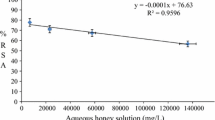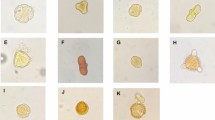Abstract
Natural products may be applied in a wide range of domains, from agriculture to food and pharmaceutical industries. In this study, the antioxidant properties and the capacity to inhibit some enzymatic activities of Euphorbia resinifera and Euphorbia officinarum aqueous extracts and honeys were assessed. The physicochemical characteristics were also evaluated. Higher amounts of iron, copper and aluminium were detected in E. officinarum honey, which may indicate environmental pollution around the beehives or inadequate storage of honey samples. This honey sample showed higher amounts of total phenols and better capacity for scavenging superoxide anion free radicals and DPPH free radicals as compared with E. resinifera honey, but poorer capacity for inhibiting lipoxygenase, acetylcholinesterase, tyrosinase and xanthine oxidase. The ratio plant mass:solvent volume (1:100) and extraction time (1 - 2 h) were associated with higher total phenols and better antioxidant activities and lipoxygenase, acetylcholinesterase and tyrosinase inhibitory activities, regardless of the plant species. The aqueous extracts had systematically higher in vitro activities than the respective honey samples.






Similar content being viewed by others
References
Aazza S, Lyoussi B, Antunes D, Miguel G (2014) Physicochemical characterization and antioxidant activity of 17 commercial Moroccan honeys. Int J Food Sci Nutr 65:449–457
Aazza S, Elamine Y, El-Guendouz S, Lyoussi B, Antunes M, Estevinho L, Anjos O, Carlier J, Costa M, Miguel G (2017) Physicochemical characterization and antioxidant activity of honey with Eragrostis spp. pollen predominance. J Food Biochem 42:1–10
Aljohar M, Maher H, Albaqami J, Al-Mehaizie M, Orfali R, Orfali R, Alrubia S (2018) Physical and chemical screening of honey samples available in the Saudi market: an important aspect in the authentication process and quality assessment. Saudi Pharm J 26:932–942
Basma AA, Zakaria Z, Latha LY, Sasidharan S (2011) Antioxidant activity and phytochemical screening of the methanol extracts of Euphorbia hirta L. Asian Pac J Trop Med 4:386–390
Bettara I, González-Miret M, Hernanz D, Marconi A, Herediab F, Terrab A (2015) Characterisation of Moroccan spurge (Euphorbia) honeys by their physicochemical characteristics, mineral contents and colour. Arab J Chem 12:2052–2060
Bogdanov S (2009) Harmonised methods of the International Honey Commission. IHC: 1-62
Bouhlali T, Bammou M, Sellam K, Ramchoun M, Benlyas M, Alem C, Filali-Zegzouti Y (2016) Evaluation of antioxidant, antibacterial and antifungal activities of eleven monofloral honey samples collected from Morocco. J Chem Pharm Res 8:299–306
Bruyns P, Klak C, Hanáček P (2011) Age and diversity in old world succulent species of Euphorbia (Euphorbiaceae). Taxon 60:1717–1733
Chakir A, Romane A, Marcazzan G, Ferrazzi P (2016) Physicochemical properties of some honeys produced from different plants in Morocco. Arab J Chem 9:S946–S954
Chen CH, Chan HC, Chu YT, Ho HY, Chen PY, Lee TH, Lee CK (2009) Antioxidant activity of some plant extracts towards xanthine oxidase, lipoxygenase and tyrosinase. Molecules 14:2947–2958
Chis A, Szabó E, Borbély M, Czipa N, Purcǎrea C (2012) Comparative study of acacia and rape honey. Analele Universității din Oradea, Fascicula: Ecotoxicologie, Zootehnie și Tehnologii de Industrie Alimentară 12:325-332.
Codex Alimentarius Commission (1999) Joint Fao/WHO Food Standards Programme. FAO 12:1–10
Daoubi M, Marquez N, Mazoir N, Benharref A, Hernández-Galán R, Muñoz E, Collado IG (2007) Isolation of new phenylacetylingol derivatives that reactivate HIV-1 latency and a novel spirotriterpenoid from Euphorbia officinarum latex. Bioorg Med. Chem. 15:4577-4584.
De Sousa J, De Souza E, Marques G, Meireles B, Cordeiro A, Gullon B, Pintado M, Magnan M (2016) Polyphenolic profile and antioxidant and antibacterial activities of monofloral honeys produced by Meliponini in the Brazilian semiarid region. Food Res Int 84:61–68
Di Petrillo A, Santos-Buelga C, Era B, Gonzalez-Paramás A, Tuberoso C, Medda R, Pintus F, Fais A (2018) Sardinian honeys as sources of xanthine oxidase and tyrosinase inhibitors. Food Sci Biotechnol 27:139–146
Elamine Y, Aazza S, Lyoussi B, Antunes M, Estevinho L, Anjos O, Resende M, Faleiro M, Miguel M (2017) Preliminary characterization of a Moroccan honey with a predominance of Bupleurum spinosum pollen. J Apic Res 57:153–156
Elamine Y, Lyoussi B, Anjos O, Estevinho L, Aazza S, Carlier J, Costa M, Miguel M (2019) Zantaz honey “monoflorality”: chemometric applied to the routinely assessed parameters. LWT-Food Sci Technol 106:29–36
El-Guendouz S, Aazza S, Lyoussi B, Antunes M, Faleiro M, Miguel G (2016) Anti-acetylcholinesterase, antidiabetic, anti-inflammatory, antityrosinase and antixanthine oxidase activities of Moroccan propolis. Int J Food Sci Technol 51:1762–1773
El-Guendouz S, Aazza S, Lyoussi B, Bankova V, Popova M, Neto L, Faleiro M, Miguel G (2018) Moroccan propolis: a natural antioxidant, antibacterial, and antibiofilm against Staphylococcus aureus with no induction of resistance after continuous exposure. Evid-Based Complement Alternat Med 1-19
EU (European Union Directive) (2002) Council directive 2001/110 relating to honey. 16:1–12 (2002)
Farah H, Ech-Chahad A, Lamiri A (2014) Antioxidant, antimicrobial and phytochemical investigations of polar extracts of Euphorbia resinifera Beg., roots, stems and flowers. Am J Adv Drug Deliv 2:776–785
Griess reagent kit for nitrite determination (G-7921) (2003) Molecular Probes
Gül A, Pehlivan T (2018) Antioxidant activities of some monofloral honey types produced across Turkey. Saudi J Biol Sci 25:1056–1065
Hermosin I, Chicón R, Cabezudo M (2003) Free amino acid composition and botanical origin of honey. Food Chem 83:263–268
Jantakee K, Tragoolpua Y (2015) Activities of different types of Thai honey on pathogenic bacteria causing skin diseases, tyrosinase enzyme and generating free radicals. Biol Res 48:1–11
Kabbaj F, Meddah B, Cherrah Y, Faouzi M (2012) Ethnopharmacological profile of traditional plants used in Morocco by cancer patients as herbal therapeutics. J Phytopharmacol 2:243–256
Kıvrak S, Kıvrak İ (2016) Assessment of phenolic profile of Turkish honeys. Int J Food Prop 20:864–876
Louveaux J, Maurizio A, Vorwohl G (1978) Methods of melissopalynology. Bee World 5:139–153
Mazoira N, Benharref A, Bailén M, Reina M, González-Coloma A, Martínez-Díaz RA (2011) Antileishmanial and antitrypanosomal activity of triterpene derivatives from latex of two Euphorbia species. Z Naturforsch C J Biosci 66:360–366
Mondragon-Cortez P, Ulloab JA, Rosas-Ulloa P, Rodriguez-Rodriguez R, Resendiz Vazquez JA (2013) Physicochemical characterization of honey from the West region of Mexico. Cyta-J Food 11:7–13
Moujanni A, Partida L, Essamadi A, Hernanz D, Heredia F, Terrab A (2018) Physicochemical characterization of unique unifloral honey: Euphorbia resinifera. Cyta-J Food 16:27–35
Moussa A, Aissat S, Djebli N (2015) Preliminary comparative study of anti-inflammatory effect of unheated and heat-treated Sahara honey: in vivo approach. J Coastal Life Med 3:366–369
Mwine J, Van Damme P (2011) Why do Euphorbiaceae tick as medicinal plants? A review of Euphorbiaceae family and its medicinal features. J Med Plant Res 5:652–662
Naman M, Faid M, El Adlouni C (2005) Microbiological and physico-chemical properties of Moroccan honey. Int J Agric Biol 7:773–776
Nguyen MT, Awale S, Tezuka Y, Tran QL, Watanabe H, Kadota S (2004) Xanthine oxidase inhibitory activity of Vietnamese medicinal plants. Biol Pharm Bull 27:1414–1421
Peltier J, Msanda F (1995) Diversite et originalite de la steppe 5 Euphorbin oflicinarum L. subsp. echinus (hooker fil . et cosson) vindt du sud-ouest Marocain. Feddes Repertorium 106:215–229
Philip Y, Fadzelly M (2015) Antioxidative and acetylcholinesterase inhibitor potential of selected honey of Sabah, Malaysian Borneo. Int Food Res J 22:1953–1960
Sahin H (2015) Honey as an apitherapic product: its inhibitory effect on urease and xanthine oxidase. J Enz Inhib Med Chem 31:1–5
Silva C, Aazza S, Faleiro M, Miguel M, Neto L (2016) The antibacterial, anti-biofilm, anti-inflammatory and virulence inhibition properties of Portuguese honeys. J Apic Res 55:292–304
Squadrone S, Brizio P, Stella C, Mantia M, Pederiva S, Brusa F, Mogliotti P, Garrone A, Abete MC (2020) Trace elements and rare earth elements in honeys from the Balkans, Kazakhstan, Italy, South America, and Tanzania. Environ Sci Pollut Res Int 27:12646–12657
Tatjana P, Dimov I, Nakov G (2018) Quality characteristics of honey: a review. Proc Univ Ruse 57:31–37
Terrab A, Recamales A, Hernanz D, Heredia F (2004) Characterisation of Spanish thyme honeys by their physicochemical characteristics and mineral contents. Food Chem 88:537–542
Ul-Haqa I, Ullaha N, Bibia G, Kanwala S, Ahmadb M, Mirza B (2012) Antioxidant and cytotoxic activities and phytochemical analysis of Euphorbia wallichii root extract and its fractions. Iran J Pharm Sci 11:241–249
Vasas A, Rédei D, Csupor D, Molnár J, Hohmann J (2012) Diterpenes from European Euphorbia species serving as prototypes for natural-product-based drug discovery. Eur J Org Chem 27:5115–5130
Veena KS, Sameena MT, Padmakumari AKP, Srinivasa GTK, Nishanth KS, Reshma MV (2018) Development and validation of HPLC method for determination of sugars in palm sap, palm syrup, sugarcane jaggery and palm jaggery. Int Food Res J 25:649–654
Acknowledgements
The authors acknowledge Manuela David, curator of ALGU Herbarium, in supervising tasks involving the identification, preparation and deposit of the voucher specimens.
Funding
The authors would like to acknowledge the support granted from FCT under the projects UID/MAR/00350/2020; UIDB/05183/2020; UIDB/04326/2020 and UID/AGR/00690/2019
Author information
Authors and Affiliations
Corresponding author
Additional information
Responsible Editor: Mohamed M. Abdel-Daim
Publisher’s note
Springer Nature remains neutral with regard to jurisdictional claims in published maps and institutional affiliations.
Rights and permissions
About this article
Cite this article
Boutoub, O., El-Guendouz, S., Estevinho, L.M. et al. Antioxidant activity and enzyme inhibitory potential of Euphorbia resinifera and E. officinarum honeys from Morocco and plant aqueous extracts. Environ Sci Pollut Res 28, 503–517 (2021). https://doi.org/10.1007/s11356-020-10489-6
Received:
Accepted:
Published:
Issue Date:
DOI: https://doi.org/10.1007/s11356-020-10489-6




